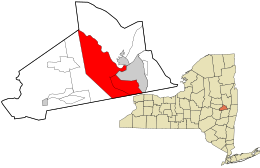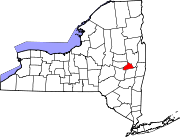Rotterdam, New York
This article needs additional citations for verification. (July 2009) |
Rotterdam, New York | |
|---|---|
 A sign depicting the entrance to town of Rotterdam on New York State Route 5 | |
| Nickname: New Italy | |
 Location in Schenectady County and the state of New York. | |
| Country | United States |
| State | New York |
| County | Schenectady |
| Settled | 1661 |
| Established | 1820 |
| Government | |
| • Supervisor | Harry Buffardi |
| Area | |
• Total | 36.4 sq mi (94.4 km2) |
| • Land | 35.7 sq mi (92.4 km2) |
| • Water | 0.8 sq mi (2.0 km2) |
| Elevation | 512 ft (156 m) |
| Population (2010) | |
• Total | 29,094 |
| • Density | 800/sq mi (310/km2) |
| Time zone | UTC-5 (Eastern (EST)) |
| • Summer (DST) | UTC-4 ((EDT)) |
| ZIP code | 12306 or 12303 |
| Area code | 518 |
| FIPS code | 36-63935 |
| GNIS feature ID | 979437 |
| Website | www |
Rotterdam is a town in Schenectady County, New York, United States. The population was 29,094 at the 2010 census.[1]
The town of Rotterdam is in the south-central part of the county. It was founded by Dutch settlers, who named it after the port of Rotterdam in the Netherlands, where many immigrants last touched European grounds. The town borders the city of Schenectady.
History
Situated near the eastern end of New York State's Heritage Corridor at what is known as the "Gateway to the West", the town of Rotterdam is closely linked with the early development of Schenectady. At that time the present town of Rotterdam served as the outlying farmlands and wood lots for the settlers. With few exceptions, these settlers made their homes in the stockade in Schenectady but went to their farmlands during the daytime.
The lands now known as Rotterdam became Schenectady's third ward when that city was incorporated in 1798. Rotterdam retained that status when the county of Schenectady was chartered in 1809. During this period, a council of aldermen and assistants from each of the four wards governed the city of Schenectady. In May 1819, the city council recommended that the third and fourth wards be separated out as towns, and on December 31, a petition to the state legislature was drafted. The legislation was passed on April 14, 1820, the final day of the legislative session, creating the town of Rotterdam.
The Dellemont-Wemple Farm was added to the National Register of Historic Places in 1973, and the Enlarged Double Lock No. 23, Old Erie Canal in 2008.[2]
The Mabee House, at the Mabee Farm Historic Site, the oldest surviving house in the Mohawk Valley, was added to the National Register of Historic Places May 22, 1978. It is a property of the Schenectady County Historical Society, being donated by a last descendant in his particular line, Mr. George Eugene Franchere, on January 29, 1993, the 287th anniversary of the original deed. It is currently being operated as a living history museum, conducts school programs, and events for the public.
Geography
The Mohawk River defines the northeast town line. The New York State Thruway passes through the town.[3]
According to the United States Census Bureau, the town has a total area of 36.4 square miles (94.4 km2), of which 35.7 square miles (92.4 km2) is land and 0.77 square miles (2.0 km2), or 2.11%, is water.[4]
Government
The Rotterdam Town Board consists of five members, including the Supervisor who is a voting member.
- Town Supervisor, Harry Buffardi (D)
- Deputy Supervisor, Wayne Calder (D)
- Council Member, Rick Larmour (R)[5]
- Council Member, Joe Villano (R)[5]
Demographics
| Census | Pop. | Note | %± |
|---|---|---|---|
| 1820 | 1,529 | — | |
| 1830 | 1,480 | −3.2% | |
| 1840 | 2,284 | 54.3% | |
| 1850 | 2,446 | 7.1% | |
| 1860 | 2,224 | −9.1% | |
| 1870 | 2,355 | 5.9% | |
| 1880 | 2,326 | −1.2% | |
| 1890 | 3,098 | 33.2% | |
| 1900 | 7,711 | 148.9% | |
| 1910 | 5,406 | −29.9% | |
| 1920 | 7,853 | 45.3% | |
| 1930 | 9,920 | 26.3% | |
| 1940 | 12,560 | 26.6% | |
| 1950 | 19,762 | 57.3% | |
| 1960 | 27,493 | 39.1% | |
| 1970 | 31,067 | 13.0% | |
| 1980 | 29,451 | −5.2% | |
| 1990 | 28,395 | −3.6% | |
| 2000 | 28,316 | −0.3% | |
| 2010 | 29,094 | 2.7% | |
| 2014 (est.) | 29,411 | [6] | 1.1% |
As of the census of 2000, there were 28,316 people, 11,544 households, and 8,092 families residing in the town. The population density was 787.0 people per square mile (303.9/km²). There were 11,990 housing units at an average density of 333.3 per square mile (128.7/km²). The racial makeup of the town was 97.26% White, 0.95% Black or African American, 0.16% Native American, 0.57% Asian, 0.01% Pacific Islander, 0.21% from other races, and 0.83% from two or more races. Hispanic or Latino of any race were 0.97% of the population.[8]
There were 11,544 households out of which 29.4% had children under the age of 18 living with them, 55.7% were married couples living together, 10.6% had a female householder with no husband present, and 29.9% were non-families. 25.8% of all households were made up of individuals and 12.6% had someone living alone who was 65 years of age or older. The average household size was 2.44 and the average family size was 2.94.[8]
In the town the population was spread out with 23.1% under the age of 18, 5.8% from 18 to 24, 27.9% from 25 to 44, 24.1% from 45 to 64, and 19.1% who were 65 years of age or older. The median age was 41 years. For every 100 females there were 92.9 males. For every 100 females age 18 and over, there were 88.5 males.[8]
The median income for a household in the town was $46,267, and the median income for a family was $54,542. Males had a median income of $37,536 versus $27,527 for females. The per capita income for the town was $21,457. About 2.8% of families and 4.5% of the population were below the poverty line, including 5.2% of those under age 18 and 5.9% of those age 65 or over.[8]
Communities and locations in Rotterdam
- Antonia Hills- A small development off of Route 7; built by the Valentine Family.
- Colonial Manor – A well-sized community between Cold Brook and South Schenectady, with housing developed in the 1950s by Charles Juracka.
- Carman – A relatively small community anchored by Carman Park.
- Cold Brook – A well-sized suburban community placed on the former Campbell Family estate.
- Eldorado Acres
- Galluci Gadrdens; A cul-de-sac with a handful of single-family detached homes, and 3-4 Tudor homes and a few colonial homes.
- Lower Rotterdam Junction – A hamlet south of Rotterdam Junction on Route 5S.
- Pattersonville – A hamlet in the northern part of the town on the town line.
- Rotterdam – A large suburban community west of Schenectady.
- Rotterdam Junction – A hamlet near the Mohawk River on Route 5S.
- Schonowe
- Serafini Gardens – A medium sized development on the border of Guilderland and Rotterdam. Contains 50-75 homes.
- South Schenectady
- Skyline; Development sitting on a big hill overlooking rotterdam, with about 15-20 homes.
- Sunrise Estates/Caroline Manor
Italian heritage
Although the town was settled by the Dutch, Rotterdam is heavily populated by people with Italian heritage. Nearly 80% of all households have someone who is at least 25% Italian; because of this, Italian restaurants are very common in Rotterdam.
See also
References
- ^ "Profile of General Population and Housing Characteristics: 2010 Demographic Profile Data (DP-1): Rotterdam town, Schenectady County, New York". U.S. Census Bureau, American Factfinder. Retrieved 2012-07-05.
- ^ "National Register Information System". National Register of Historic Places. National Park Service. March 13, 2009.
- ^ http://www.thruway.ny.gov/travelers/interchanges/commuter-lots.html
- ^ "Geographic Identifiers: 2010 Demographic Profile Data (G001): Rotterdam town, Schenectady County, New York". U.S. Census Bureau, American Factfinder. Retrieved 2012-07-05.
- ^ a b http://www.rotterdamny.org/
- ^ "Annual Estimates of the Resident Population for Incorporated Places: April 1, 2010 to July 1, 2014". Retrieved June 4, 2015.
- ^ "Census of Population and Housing". Census.gov. Retrieved June 4, 2015.
- ^ a b c d "American FactFinder". United States Census Bureau. Retrieved 2008-01-31.


